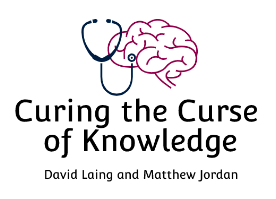Lesson 2: Reader-Centric Writing
Hello and welcome to lesson two of Curing the Curse of Knowledge! Last time, we tried to persuade you that the Curse of Knowledge is a major cause of bad writing. In this lesson, we discuss the best antidote to the Curse of Knowledge: reader-centric writing.
What is the purpose of writing? The most obvious answer is communication. You write to inform, to entertain, to persuade, to teach, and to express yourself. But writing has another major purpose that is often overlooked: thinking. If you’ve ever started writing something, only to find that you have no clue what you want to say, you’ll appreciate that it’s only through writing that you can unjumble your thoughts, figure out your message, and identify your supporting points.
Writing to think and writing to communicate are fundamentally different activities. Writing to think is an act of exploration, while writing to communicate is an act of empathy. When you successfully empathize with your reader and shape your writing to serve their purposes, rather than merely cataloguing your own thoughts, you produce what is called reader-centric writing. Reader-centric writing is a designed object, deliberately crafted to anticipate the reader’s state of mind at every step of the way. It’s really hard to produce.
The main reason why reader-centric writing is hard to produce is, of course, the Curse of Knowledge: it’s hard to imagine inhabiting another person’s mind. But the difficulty is exacerbated by the fact that we never got to practice reader-centric writing in school.
In school, you rarely write for anyone except your teachers, who are a highly unusual audience. For one thing, they are contractually obligated to read your writing from start to finish. They are literally paid to pay attention to you. For another, they read with a red pen in hand—not to take notes so they can better understand the ideas you’re conveying, but to evaluate your understanding of those ideas.
School therefore gives you a warped perspective on what writing is for. It trains you to think that writing is about proving how smart you are, demonstrating your understanding, and revealing the contents of your mind so that you can earn an A+. Outside of school, however, your readers are rarely forced to pay attention to you. They are reading for their own benefit. They don’t care how smart you are, or how much you’ve learned. What they want to know is, “what’s in it for me?”
Fortunately, there is a simple technique you can use to put yourself on the path to reader-centric writing. The technique is to choose a specific individual as your imaginary reader, rather than an abstract description of a person or group. Don’t write for your blog readers, your coworkers, or your research community; write for your friend, or for your boss, or for your mother. The Curse of Knowledge will still pose challenges, but at least you will picture a real person interacting with your ideas, which will help to jumpstart your empathy.
When selecting an imaginary reader, there are a couple of things you should keep in mind. First, you should pick someone who is representative of your actual readers. If your audience is the attendees of an electrical engineering conference, you should probably not choose someone who has never heard of a capacitor. One of us (Matthew) wrote all of his university essays with the other (David) in mind, since David is a graduate-educated interdisciplinary thinker: precisely the market Matthew was aiming for.
Second, you should try to pick someone you know well. That way, instead of wondering “does my audience know what the Treaty of Tordesillas is?”, you can simply ask yourself “does David know what the Treaty of Tordesillas is?” And if you’re not sure, you can ask the person directly!
For this lesson’s activity, we’d like to give you a simple task: assemble a small cast of imaginary readers. Try to pick one specific reader for each of the main contexts in which you write. Next time you write something, once you’ve made it past the thinking stage to the communication stage, imagine that reader perched like an angel on your shoulder. Do they understand what you’re trying to say? Are they convinced of its importance? Which parts are making them groan, or smile, or furrow their brow? You won’t know for sure until you show them your work, but at least you can design your writing with that person in mind.
In the next lesson, we’ll dig into a form of writing that requires immense empathy for readers: explanation.
